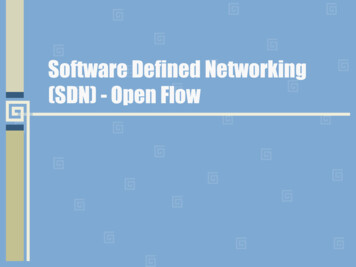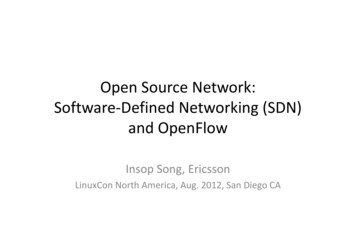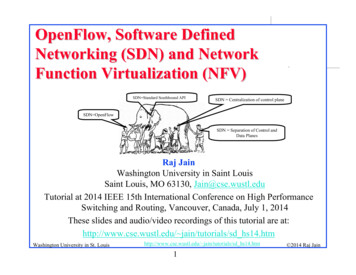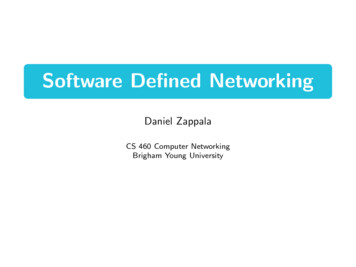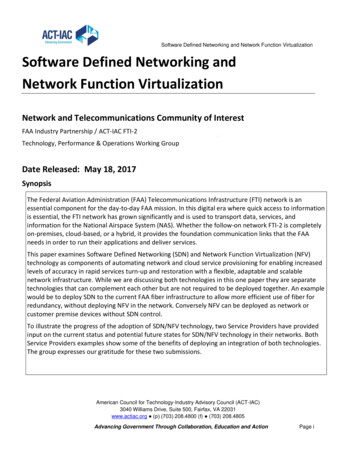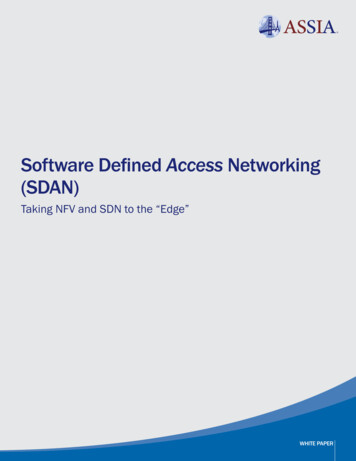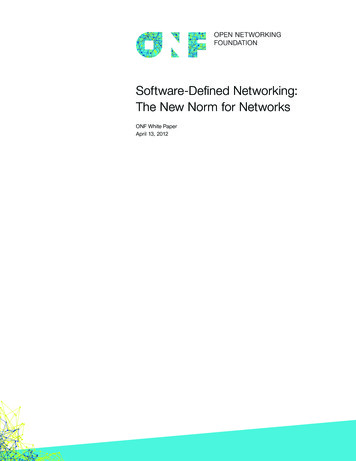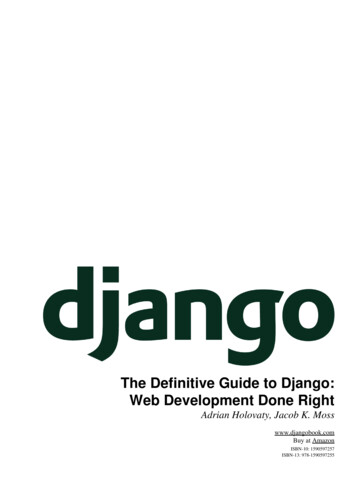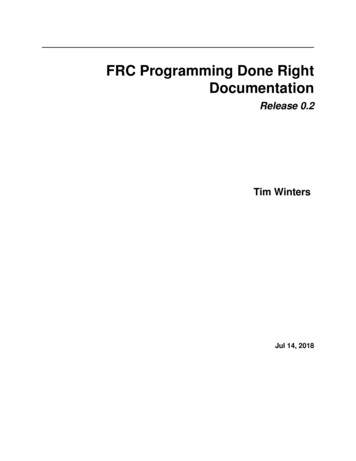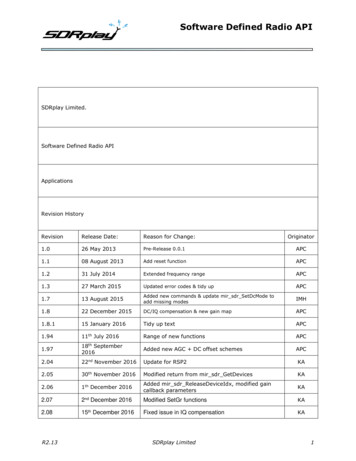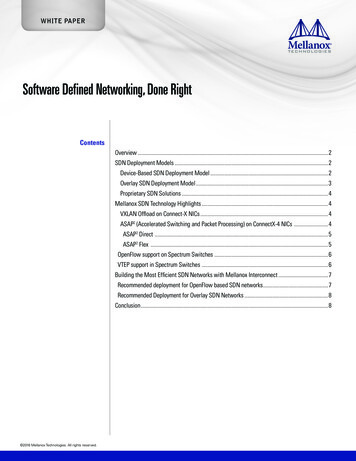
Transcription
WHITE PAPERSoftware Defined Networking, Done RightContentsOverview.2SDN Deployment Models.2Device-Based SDN Deployment Model.2Overlay SDN Deployment Model.3Proprietary SDN Solutions.4Mellanox SDN Technology Highlights.4VXLAN Offload on Connect-X NICs.4ASAP2 (Accelerated Switching and Packet Processing) on ConnectX-4 NICs .4ASAP2 Direct .5ASAP2 Flex .5OpenFlow support on Spectrum Switches .6VTEP support in Spectrum Switches .6Building the Most Efficient SDN Networks with Mellanox Interconnect.7Recommended deployment for OpenFlow based SDN networks.7Recommended Deployment for Overlay SDN Networks.8Conclusion.8 2016 Mellanox Technologies. All rights reserved.
WHITE PAPER: Software Defined Networking, Done RightOverviewpage 2Software-Defined Networking (SDN) is a revolutionary approach to designing, building and operatingnetworks that aims to deliver business agility in addition to lowering capital and operational coststhrough network abstraction, virtualization and orchestration. Conceptually, SDN decouples the controland data planes, and logically centralizes network intelligence and control in software-based controllersthat maintain a global view of the network. This enables more streamlined policy-driven external controland automation from applications, which ultimately enhances network programmability and simplifiesnetwork orchestration. As such, SDN-based design allows for highly elastic networks that can readilyadapt to changing business needs.The first wave of SDN deployment focuses on functionality, but with many innovations and enhancementsin data center interconnect technologies, it is time to take a fresh look at more efficient, higherperformance SDN deployment options.In this white paper, we focus on SDN solutions for data centers, which is often an essential part ofbuilding cloud, whether it is private cloud or public cloud. It covers the following topics: Overview of the dominant SDN deployment models; Mellanox SDN technology highlights, where we discussed the key Mellanox features and products thatmake SDN deployment more efficient; Mellanox SDN solutions for OpenFlow and Overlay SDN deployment models. We show how theMellanox products and features are put together to deliver total solution in various SDN deploymentscenarios and the key benefits the Mellanox solutions deliver.SDN Deployment ModelsThree different deployment models dominate today’s SDN landscape:Device-Based SDN Deployment ModelIn this model, the SDN Controller uses a south-bound device control protocol to directly communicatepolicy or forwarding table information to the physical and virtual switching and routing devices. OpenFlowis the most commonly used protocol, and some of the early SDNarchitectures are based on OpenFlow to decouple control planefrom network devices.Examples of SDN implementations based on this model areBigSwitch’s Big Cloud Fabric, Open Networking Lab(ON.LAB)’sONOS, and Open Daylight (ODL). Beyond OpenFlow, ONOS andODL also support other southbound protocols such as Netconfand SNMP for device configuration and management.Essentially for every new flow, all the devices that this flowtraverses potentially needs to be programmed to handle theproper flow operations. This model requires the network devicesto be OpenFlow-aware, which can sometimes be a challengewhen you have legacy networks or a mixture of variousgeneration of network devices. 2016 Mellanox Technologies. All rights reserved.
WHITE PAPER: Mellanox SDN Solutionpage 3Overlay SDN Deployment ModelMany customers have an installed base of networking equipment that is not yet OpenFlow-enabled,and doing a network-wide upgrade may not be an option. Overlay approach of SDN deployment modelcame into being to bring SDN/network virtualization to thesecustomers without requiring forklift network upgrade that can beboth expensive and disruptive to business services. Overlay SDNhas been the most commonly seen architecture, and mainstreamSDN solutions such as VMware NSX, Nuage Networks (Now part ofNokia) VSP, PLUMGrid ONS, OpenContrail and Midokura MidoNet allprimarily follow this model.As the name indicates, in overlay model, logical networks areestablished through tunnels between endpoints, and these tunnelsare overlaid onto an existing physical network. The intelligenceabout multi-tenancy, network and security policies are pushed to thenetwork edge. Some of the most commonly used tunneling protocolsinclude Virtual eXtensible LAN (VXLAN), Network Virtualizationusing GRE (NVGRE), and Generic Network VirtualizationEncapsulation (GENEVE). In case of VXLAN, the tunnel endpoints areknown as VXLAN Tunnel End Points (VTEP). The physical network, orthe underlay, becomes the “core” network and its functionalities canpotentially be simplified to providing high-performance IP connectivity between these VTEPs. An overlaySDN controller will primarily communicate with the VTEPs, which oftentimes are the virtual switching androuting device residing on servers.Overlay SDN can be deployed to achieve network virtualization and automation without requiringupgrades of physical networking equipment, more specifically, the network devices that are NOT theVTEPs. Despite its pluses, overlay SDN introduce added complexity when it comes to managing both theoverlay and underlay, and correlating information from both layers during troubleshooting.There are two common ways to deploy VTEP: software VTEP in virtual switches, normally running inserver hypervisors; or hardware VTEP in Top of Rack (ToR) switches, and there are tradeoffs betweenthese two approaches. Software VTEP is flexible and conceptually simple, but can impact performance aswell as raise CPU overhead on edge devices due to the packet processing associated with the relativelynew tunneling protocols that not all server Network Interface Cards (NICs) can offload from CPU. This canbe even more pronounced when the applications themselves are virtualized network functions (VNFs) inNetwork Function Virtualization (NFV) deployment. Hardware VTEPs can often achieve higher performancebut pose added complexity on the ToR switch since the ToR switch needs to be VM-aware, maintain alarge forwarding table, and performance VM Mac address or VLAN to VXLAN translations.Software VTEPHardware VTEPBeyond the virtualized environment with VXLAN/NVGRE/GENEVE, there are often Bare Metal Servers(BMS) or legacy networks that can only use VLAN, or North-South traffic that goes out to a VPN networkor the Internet. In those cases, using a software VTEP gateway adds extra hop or potentially performancebottleneck and the best practice is to use the ToR that the BMS is connected to as hardware VTEP. 2016 Mellanox Technologies. All rights reserved.
WHITE PAPER: Software Defined Networking, Done Rightpage 4Proprietary SDN SolutionsThere are other proprietary SDN solutions in the market, such as Cisco Application Centric Infrastructure(ACI), Plexxi and Pluribus. With these solutions, the SDN controller and the SDN switching and routingelements are often tightly coupled. This category of SDN solutions are not as open as the above two, andpose limitations for ecosystem vendors to integrate with them. Mellanox currently works with only openSDN solutions.Mellanox SDNTechnology HighlightsVXLAN Offload on Connect-X NICsIn the good old days when network virtualization was realized through VLAN, achieving line rateperformance on the server host is possible because the server can offload some of the CPU-intensivepacket processing operations such as checksum, Receive Side Steering (RSS), Large Receive Offload(LRO) etc. into the NIC hardware. This both improves network I/O performance and reduces CPUoverhead, ultimately making the infrastructure run more efficiently.As mentioned in the above section, with overlay SDN, a tunneling protocol such as VXLAN, NVGREor GENEVE is introduced to encapsulate the original payload. For NICs that don’t recognize these newpacket header formats, even the most basic offloads stop functioning, resulting in all packet manipulatingoperations to be done in software in CPU. This can cause significant network I/O performancedegradation and excessive CPU overhead, especially when server I/O speed evolves from 10Gb/s to 25,40, 50, or even 100Gb/s.Starting from ConnectX-3 Pro series of NIC, Mellanox supports VXLAN hardware offload that includesstateless offloads such as checksum, RSS, and LRO for VXLAN/NVGRE/GENEVE packets. With VXLANoffload, I/O performance and CPU overhead can be restored to similar levels as VLAN.The following two graphs shows the bandwidth and CPU overhead comparison in three scenarios: VLAN,VXLAN without offload, and VXLAN with offload. VXLAN offload results in greater than 2X throughputimprovement with approximately 50% lower CPU overhead.VXLAN Offload is supported at OS/hypervisor kernel level for Linux, Microsoft Hyper-V, and VMWareESXi, and does not depend on the type of virtual switch or router used.ASAP2 (Accelerated Switching and Packet Processing) on ConnectX-4 NICsStarting from ConnectX-4 series of NICs, Mellanox support VTEP capability in server NIC hardwarethrough the ASAP2 feature. With a pipeline-based programmable eSwitch built into the NIC, ConnectX-4can handle a large portion of the packet processing operations in hardware. These operations includeVXLAN encapsulation/decapsulation, packet classification based on a set of common L2 – L4 headerfields, QoS and Access Control List (ACL). Built on top of these enhanced NIC hardware capabilities,ASAP2 feature provides a programmable, high-performance and highly efficient hardware forwardingplane that can work seamlessly with SDN control plane. It overcomes the performance degradationissues associated with software VTEP, as well as complexity issues of coordinating between server andTOR devices in case of hardware VTEP. 2016 Mellanox Technologies. All rights reserved.
WHITE PAPER: Software Defined Networking, Done Rightpage 5There are two main ASAP2 deployment models: ASAP2 Direct and ASAP2 FlexASAP2 DirectIn this deployment model, VMs establish direct access to Mellanox ConnectX-4 NIC hardware throughSR-IOV Virtual Function (VF) to achieve the highest network I/O performance in virtualized environment.One of the issues associated with legacy SR-IOV implementation is that it bypasses hypervisor and virtualswitch completely, and the virtual switch is not aware of the existence of VMs in SR-IOV mode. As aresult, SDN control plane could not influence the forwarding plane for those VMs using SR-IOV on theserver host.ASAP2 Direct overcomes this issue through enabling rules offload between the virtual switch and theConnectX-4 eSwitch forwarding plane. In this case, we use Open Virtual Switch (OVS), one of the mostcommonly used virtual switch for illustration. The combination of SDN control plane through OVS whocommunicates with a corresponding SDN controller, and NIC hardware forwarding plane offers the bestof both world, software-defined flexible network programmability, and high network I/O performancefor the state-of-art speeds from 10G to 25/40/50/100G. By letting the NIC hardware taking the I/Oprocessing burden from the CPU, the CPU resources can be dedicated to application processing, resultingin higher system efficiency.ASAP2 Direct offers excellent small packet performance beyond the raw bit throughput. Our benchmarkshows that on a server with 25G interface, ASAP2 Direct achieves 33 million packets per second (MPPS)with ZERO CPU cores consumed for a single flow, and about 25 MPPS with 15000 flows performingVXLAN encap/decap in ConnectX-4 Lx eSwitch.ASAP2 FlexIn this deployment model, VMs run in para-virtualized mode and still go through the virtual switch forits network I/O needs. But through a set of open APIs such as Linux Traffic Control (TC), or Data PathDevelopment Kit (DPDK), the virtual switch can offload some of the CPU intensive packet processingoperations to the Mellanox ConnectX-4 NIC hardware, including VXLAN encapsulation/decapsulation andpacket classification. This is a roadmap feature and availability date will be announced in the future. 2016 Mellanox Technologies. All rights reserved.
WHITE PAPER: Software Defined Networking, Done Rightpage 6OpenFlow support on Spectrum SwitchesSpectrum is Mellanox’s 10/25/40/50 and 100Gb/s Ethernet switch solution that is optimized for SDN toenable flexible and efficient data center fabrics with leading port density, low latency, zero packet loss,and non-blocking traffic.From the ground up, at the switch silicon level, Spectrum is designed to have a very flexible processingpipeline so that it can accommodate programmable OpenFlow pipeline that allow packets to be sent tosubsequent tables for further processing and allow metadata information to be communicated betweenOpenFlow tables. In addition, Spectrum is an OpenFlow-hybrid switch that supports both OpenFlowoperation and normal Ethernet switching operation. Users can configure OpenFlow at port level,assigning some Spectrum ports to perform OpenFlow based packet processing operations and othersto perform normal Ethernet switching operations. In addition, Spectrum also provides a classificationmechanism to direct traffic within one switch port to either the OpenFlow pipeline or the normalEthernet processing pipeline.Here is a summary of the OpenFlow features supported on Spectrum: OpenFlow 1.3 Control packet parsing»» Mapping interfaces to OpenFlow hybrid ports Interoperability with Open Daylight and ONOS controllers. Set OpenFlow bridge DATAPATH-ID Show configured flows by controller Supporting flex rules in hardware using ACLs Query table features Table Actions – Add, Delete, Modify, Priority, Hard Timeout Configurable remote controllers:»» Selective send to controller Per port counters Per port state:»» STP»» Operation»» SpeedVTEP support in Spectrum Switches Layer 2 VTEP gateway between virtualized networks using VXLAN and non-virtualized networks usingVLAN in the same data center or between data centers. Layer 2 VTEP gateway to provide high-performance connection to virtualized servers across Layer3 networks and enable Layer 2 features such as VM live migration (VMotion). On virtualized serverhosts where the NIC does not have VTEP capability and software VTEP can’t meet the network I/Operformance requirement, the VTEP can be implemented on Mellanox Spectrum ToR. In some cases,the application running in the VM may desire to use advanced networking features such as RemoteDirect Memory Access (RDMA) for inter-VM communication or access to storage. RDMA needs to runin SR-IOV mode on virtualized servers and in cases when Mellanox NIC is not present, the VTEP is bestimplemented in the ToR. Layer 3 VTEP gateway that provide VXLAN routing capability for traffic between different VXLAN virtualnetworks, or for north-south traffic between an VXLAN network and a VPN network or the Internet. Thisfeature is supported in Spectrum hardware, and the software to enable it is still under development.Spectrum is an Open Ethernet switch and can support multiple switch operating system running over 2016 Mellanox Technologies. All rights reserved.
WHITE PAPER: Software Defined Networking, Done Rightpage 7it. The Layer 2 VTEP gateway features will first be available in Cumulus Linux over Spectrum, andsubsequently in MLNX-OS.This achieves line rate performance while saving on compute and storage costs.Some of the major storage protocols and platforms are RDMA-enabled today. Examples include iSER(iSCSI over RoCE), SMB Direct, iSER within OpenStack’s Cinder, Ceph RDMA, and other.iSER and SMBDirect performance advantages below:Building the Most EfficientSDN Networks withMellanox InterconnectIn this section, we recommend best practice when it comes to building the most efficient SDN networksfor OpenFlow and Overlay based models.Recommended deployment for OpenFlow based SDN networksHighlights: Leaf-Spine architecture built using Spectrum switches with OpenFlow 1.3 support For physical virtual fabric, leverage ASAP2 to offload virtual switch data plane to Mellanox ConnectX-4 NICs Advanced flow monitoring with SFLOW capabilities on SpectrumKey benefits: High performance, line rate performance at any speed from 10G to 100Gb/s, including on virtualizedservers Most flexible OpenFlow switch implementation In-depth visibility into the OpenFlow fabric 2016 Mellanox Technologies. All rights reserved.
WHITE PAPER: Software Defined Networking, Done Rightpage 8Recommended Deployment for Overlay SDN NetworksHighlights: Multiple ways for virtualized server deployments:»» Virtual switch as VTEP Mellanox VXLAN stateless offload»» Mellanox NIC as VTEP (Leverage ASAP2 to offload virtual switch data plane to Mellanox ConnectX-4NICs, while keeping SDN control plane operations in virtual switch)»» For VMs who needs SR-IOV, and the legacy NIC does not support ASAP2, use Mellanox SpectrumToR as VTEP High-performance hardware VTEP on Mellanox Spectrum ToR for bare metal server or storage provisioning (Roadmap Feature) High-performance hardware Layer 3 VTEP on Mellanox Spectrum spine switches forVXLAN routing. Advanced underlay fabric monitoring with SFLOW capabilities on SpectrumKey benefits: High performance, line rate performance at any speed from 10G to 100Gb/s, including on virtualizedservers; Most advanced and future-proof VTEP implementation with flexibility to do VTEP either at NIC orswitch level, with potential to extend to Layer 3 hardware VTEP without forklift upgrade; In-depth visibility into the SDN underlay fabric to facilitate correlation of stats from both layers andachieve easy troubleshooting.ConclusionSDN is an evolving technology, and Mellanox is the only data center networking solution vendor that canprovide the most comprehensive, flexible and efficient SDN support through our end-to-end interconnectand associated software.350 Oakmead Parkway, Suite 100, Sunnyvale, CA 94085Tel: 408-970-3400 Fax: 408-970-3403www.mellanox.com Copyright 2016. Mellanox Technologies. All rights reserved.Mellanox, BridgeX, ConnectX, CORE-Direct, InfiniBridge, InfiniHost, InfiniScale, PhyX, SwitchX, Virtual Protocol Interconnect and Voltaire are registered trademarks of Mellanox Technologies, Ltd.Connect-IB, CoolBox, FabricIT, Mellanox Federal Systems, Mellanox Software Defined Storage, MetroX, MLNX-OS, ScalableHPC, Unbreakable-Link, UFM and Unified Fabric Manager are trademarksof Mellanox Technologies, Ltd. All other trademarks are property of their respective owners.M
In this white paper, we focus on SDN solutions for data centers, which is often an essential part of building cloud, whether it is private cloud or public cloud. It covers the following topics: Overview of the dominant SDN deployment models; Mellanox SDN technology highlights, where
